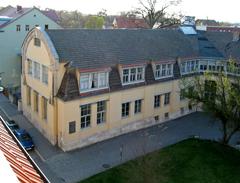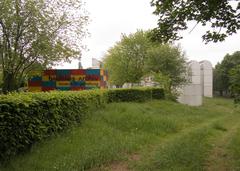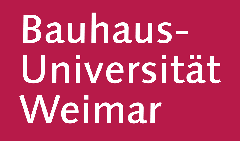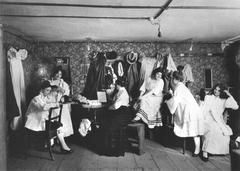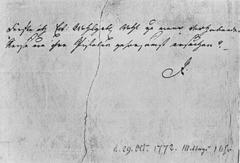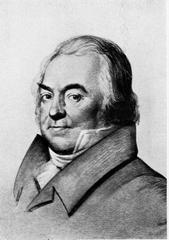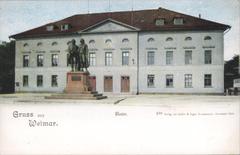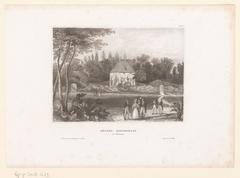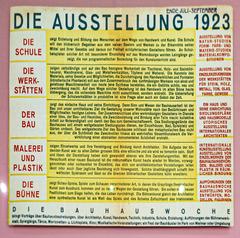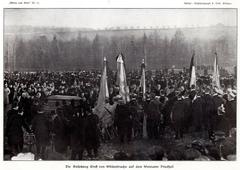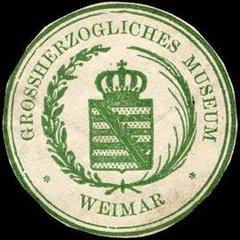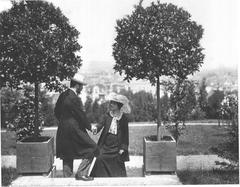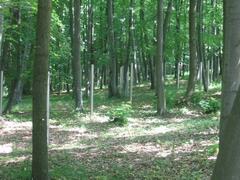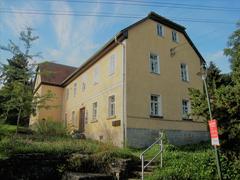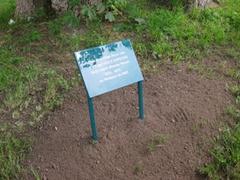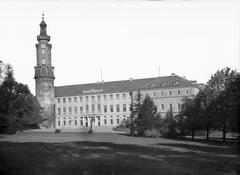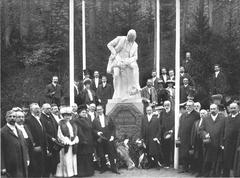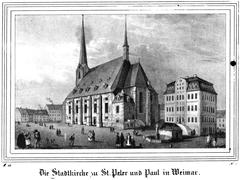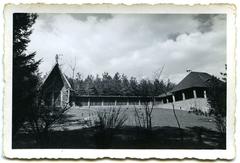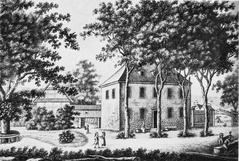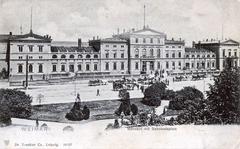Schloss Belvedere Visiting Hours, Tickets, and Guide to Weimar Historical Sites
Date: 14/06/2025
Introduction
Schloss Belvedere, located on a wooded hill just south of Weimar, is one of Germany’s finest Baroque palaces and a central highlight among Weimar historical sites. Commissioned by Duke Ernst August I of Saxe-Weimar and Eisenach and completed in 1748, this former summer residence and hunting lodge offers visitors an immersive journey into 18th-century aristocratic life, splendid architecture, and beautifully curated gardens. As part of the UNESCO World Heritage “Classical Weimar,” Schloss Belvedere not only reflects the era’s harmonious blend of art, science, and nature—shaped by figures like Duchess Anna Amalia, Duke Carl August, and Johann Wolfgang von Goethe—but also stands today as a museum and cultural landmark (Klassik Stiftung Weimar; museum.de).
This detailed guide provides essential information on Schloss Belvedere visiting hours, tickets, accessibility, facilities, and travel tips. It also situates the palace within the broader context of Weimar historical sites, encouraging visitors to explore the city’s rich cultural landscape. Whether you are a history enthusiast, art lover, or nature seeker, Schloss Belvedere promises a memorable experience in the heart of Germany (UNESCO; Lonely Planet).
Table of Contents
- Introduction
- Historical Overview
- Baroque Architecture and Park Design
- Decorative Arts and Museum Collections
- Weimar Classicism and Goethe’s Influence
- Visiting Schloss Belvedere: Practical Information
- Preservation, Restoration, and World Heritage Status
- Frequently Asked Questions (FAQ)
- Plan Your Visit and Stay Connected
- References
Historical Overview
Origins and Construction (1724–1748)
Schloss Belvedere was commissioned by Duke Ernst August I of Saxe-Weimar and Eisenach as a summer residence and hunting lodge. Construction began in 1724 and was completed in 1748, led by master builder Gottfried Heinrich Krohne with contributions from Johann Adolph Richter (Klassik Stiftung Weimar). The estate’s design, inspired by Vienna’s Belvedere Palace, features a central corps de logis, symmetrical pavilions, an observation tower, and a rounded forecourt with a fountain (Wikipedia).
Accompanying the main palace were an orangery, menagerie, stables, and guest houses—now named after famous composers—emphasizing its role as both a leisure retreat and a hub of courtly culture (Weimar.de).
Aristocratic Retreat and Garden Development
Initially, Schloss Belvedere served as a hunting lodge and summer retreat, with formal French gardens, geometric parterres, and a star-shaped animal enclosure (Wikipedia). The orangery and gardener’s house, built between 1731 and 1760, expanded the estate’s impressive horticultural landscape (Weimar.de).
Cultural Revival and Museum Era
After a period of neglect, Duchess Anna Amalia revitalized the palace in the late 18th century, turning it into a center of courtly culture (Schatzkammer Thüringen). Duke Carl August and Goethe promoted botanical studies that led to a renowned botanical garden by 1820 (Weimar.de). The gardens were later redesigned in the English landscape style, and the Russian Garden was added for Grand Duchess Maria Pavlovna. By the 20th century, Schloss Belvedere became a museum of 18th-century arts and crafts (Weimar.de), and in 1998, it was inscribed as part of the UNESCO World Heritage “Classical Weimar” (UNESCO).
Baroque Architecture and Park Design
Schloss Belvedere is a textbook example of early 18th-century Baroque architecture, with a two-winged palace, ornate stucco, and a symmetrical layout reflecting the grandeur of the era (museum.de). The palace’s interiors boast period furniture, elaborate ceiling frescoes, and Rococo embellishments that evoke the lifestyle of the Weimar ducal court. The Orangery, a U-shaped, two-story building, was designed both for exotic plants and courtly gatherings (discoverwalks.com).
Surrounding the palace is a 43-hectare park, initially laid out in the French Baroque style and later transformed with romantic and English landscape elements. The gardens feature ornamental niches, fountains, the Russian Garden, a labyrinth, and the Great Grotto, offering a harmonious blend of art and nature (museum.de; planetware.com).
Decorative Arts and Museum Collections
Since 1923, the palace has housed a museum focused on 18th-century arts and crafts (museum.de). Highlights include:
- Porcelain and Glassware: Notable collections reflecting ducal taste and international connections (planetware.com).
- Weapons and Armor: Historical arms and ceremonial objects.
- Period Furniture and Décor: Original rooms such as the Round Table Room and Poet’s Room, with portraits of the ducal family, Goethe, and Schiller.
- Artworks: Drawings, prints, and a significant coin collection, illuminating the court’s artistic and intellectual pursuits.
Weimar Classicism and Goethe’s Influence
Schloss Belvedere played a pivotal role in the Weimar Classicism movement. Goethe and Duke Carl August conducted botanical research here, and the palace became a retreat for writers, musicians, and philosophers of the era (museum.de; discoverwalks.com). The Poet’s Room and other preserved spaces celebrate the creative spirit that earned Weimar its reputation as a cultural capital.
Visiting Schloss Belvedere: Practical Information
Opening Hours
- April to October: Tuesday to Sunday, 10:00 AM – 6:00 PM
- November to March: Tuesday to Sunday, 10:00 AM – 4:00 PM
- Closed: Mondays and public holidays
Always check the official Klassik Stiftung Weimar website for seasonal and special closure updates.
Ticket Prices
- Adults: €8
- Reduced (students, seniors, etc.): €5
- Children under 18: Free
- Family and group tickets: Available
Tickets can be purchased at the entrance or online. Entry to the park is always free (Tourispo).
Accessibility
Most of the palace and park are accessible for wheelchair users, though some upper floors and garden paths may be challenging. Wheelchairs are available on site, and visitors are encouraged to contact the site ahead for tailored support (Klassik Stiftung Weimar).
Getting There and Parking
- Address: Schloss Belvedere, An der Belvedere 1, 99425 Weimar
- By car: Parking available near the entrance.
- By public transport: Bus lines 1 and 2 connect the city center to the palace. The site is also accessible by bicycle or a 30–40 minute walk from central Weimar (Lonely Planet).
Guided Tours and Special Events
Regular guided tours in German and occasionally English provide detailed insights into the palace’s history and collections (planetware.com). The palace hosts concerts, art exhibitions, and seasonal events—check the events calendar for details.
Facilities and Visitor Services
- Restrooms and accessibility amenities
- Museum shop with books, souvenirs, and crafts
- Café (seasonal)
- Audioguides in German and English
- Picnic areas in designated park zones
Photographic Spots
Capture panoramic views from the observation tower, the Rococo interiors, the Orangery’s plant displays, and the romantic gardens.
Nearby Attractions
Enhance your cultural itinerary by visiting nearby Weimar historical sites, such as the Goethe National Museum, Bauhaus Museum, Herzogin Anna Amalia Bibliothek, and Tiefurt Mansion and Park (UNESCO; Weimar.de).
Preservation, Restoration, and World Heritage Status
Schloss Belvedere and its gardens have undergone major restorations, including the park (1974–1978), Russian Garden (1978–1982), and Orangery (1998–2014) (museum.de). The palace is a key part of the UNESCO World Heritage “Classical Weimar,” recognized since 1998 for its contribution to European culture (discoverwalks.com; UNESCO).
Frequently Asked Questions (FAQ)
Q: What are Schloss Belvedere’s opening hours?
A: Tuesday to Sunday, 10:00 AM – 6:00 PM (April–October); 10:00 AM – 4:00 PM (November–March). Closed Mondays and public holidays.
Q: How much are tickets?
A: Adults €8, reduced €5, children under 18 free. Park admission is free.
Q: Is Schloss Belvedere wheelchair accessible?
A: Most areas are accessible; contact staff for detailed information or assistance.
Q: Are guided tours available in English?
A: Yes, though most tours are in German, English tours and audioguides are available—check ahead for schedules.
Q: Can I take photographs inside the palace?
A: Photography is allowed in the gardens and select palace rooms. Flash and tripods are not permitted inside.
Q: How do I reach Schloss Belvedere from Weimar city center?
A: Take bus lines 1 or 2, cycle, or enjoy a 30–40 minute walk through scenic routes.
Plan Your Visit and Stay Connected
Plan your visit to Schloss Belvedere with confidence. Check official resources for current information on visiting hours, tickets, events, and accessibility. Enhance your experience with audioguides, the Audiala app, and stay updated via social media.
Visuals:
Summary and Call to Action
Schloss Belvedere is a highlight of Weimar’s cultural landscape—a place where Baroque architecture, artistic collections, and landscaped gardens come together in a living testament to the city’s rich history. As part of the UNESCO World Heritage “Classical Weimar,” it offers a unique blend of historical depth and modern amenities. Plan your visit today to discover the beauty and legacy of Schloss Belvedere, and explore the many treasures of Weimar’s historical sites (Klassik Stiftung Weimar; UNESCO; museum.de; Weimar.de).
References
- Klassik Stiftung Weimar: Belvedere Castle and Park
- museum.de: Schloss Belvedere
- Lonely Planet: Schloss Belvedere
- thueringen.info: Schloss Belvedere
- UNESCO: Classical Weimar
- planetware.com: Attractions in Weimar
- Tourispo: Schloss Belvedere Prices and Opening Times
- discoverwalks.com: Classical Weimar Facts
- Germany Footsteps: Things to Do in Weimar
- Schatzkammer Thüringen: Schloss und Park Belvedere bei Weimar
- palace-belvedere.com: FAQ
